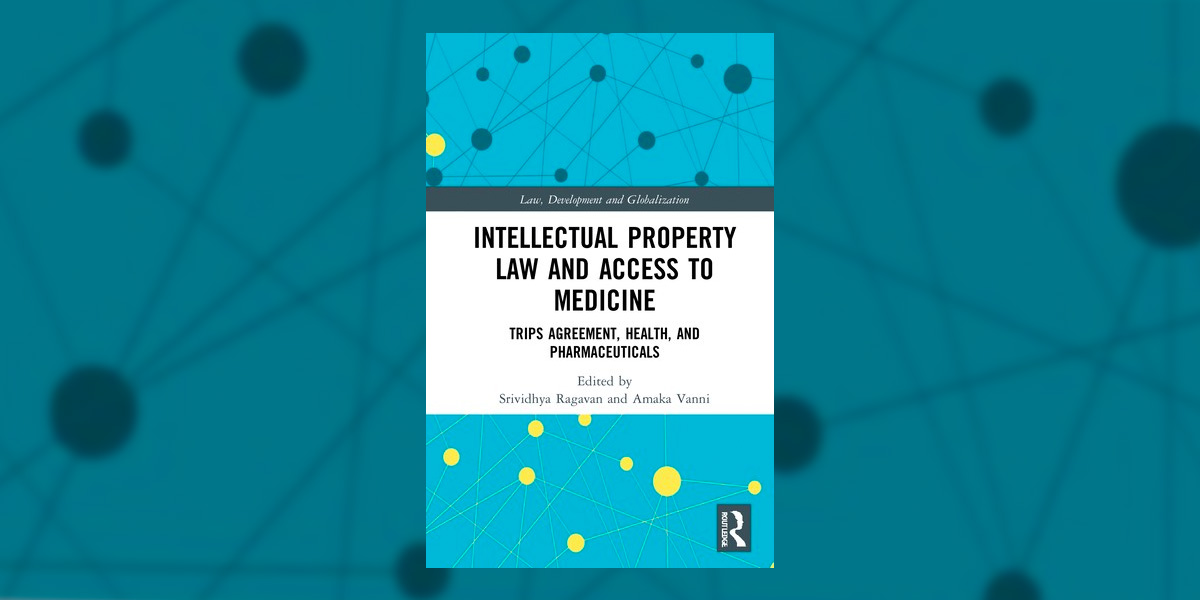
Amaka Vanni and I are pleased to share our new book, Intellectual Property Law and Access to Medicines: TRIPS Agreement, Health, and Pharmaceuticals. The book maps 25 years of TRIPS from the perspective of access to medication discourse by looking at three generations of access to medication debate.
Historically, the debate on the establishment of the WTO coincided with an era that witnessed a gradual global expansion of the concept of property to include intellectual property. The development of the scope of property rights is perhaps the most significant achievement of the post–industrial depression era. It is ironic that the global debate on IP rights gained significance not because of trade facilitated but because of the trade distorted due to the exclusion of intangibles from the property regime – the morphing of patents in life- saving medication into a luxury. This change has characterised the 25 years of the World Trade Organisation’s (WTO) Agreement on Trade-Related Aspect of Intellectual Property Rights (TRIPS Agreement).
Over time, the WTO’s global patent prescription is largely faulted for establishing economic status as the marker distinguishing those that can access life- saving medication from the rest of the population. Consequently, this decade witnessed an elevated interest over the role of patents in the context of pharmaceutical innovation. While patents slowly morphed into an important strategic business tool, there was a slow but a steady downgrading of patents from its touted original position of being the unique economic prescription to promote innovation. As such, the rhetoric of innovation, which long served as a platform to nestle “patents,” was being challenged in many industries and in many countries.
The 25 years of TRIPS can be characterized by changes that have altered our perceptions of patents. From the goals of the system, the bargaining parity of international players, the inclusions and exclusions of invested players, much has changed. The confluence of factors seemed to culminate in the year 2020 in turn elevating the imminence of the access debate in the context of the TRIPS Agreement. The fetish for encouraging patents notwithstanding, inflated prices within the US and the EU made lifesaving medication inaccessible for patients while simultaneously increasing health-care spending as a percentage of the Gross Domestic Product (GDP). Meanwhile, multilateral, plurilateral, and mega-regional trade agreements ratcheted up the standards of IP protection beyond those stipulated by the TRIPS Agreement. Amidst this, the WTO slipped into an existential crisis from a whining US, crying foul at all trading partners while creating protectionism locally in the name of ‘America First’; stalemate in the Dispute Settlement Body; an inflow of talent capital that has merged borders but raised social issues; a realization within the developed world that ‘free trade isn’t free’ but represents competition from hitherto unknown quarters of the world; and from the growing global trade tensions disrupting traditional theories of innovation. When COVID strengthened its grip on the globe in the middle of 2020, the WTO was forced to reconcile the power of public health to impact and impede trade.
Intellectual Property Law and Access to Medicines: TRIPS Agreement, Health, and Pharmaceuticals is set in this background. The book brings together leading and emerging scholars in these generations of the access to medicines debate. It critically charts the changes that represent the evolution and struggles to enable access to medication. Thus, Part I titled International Norm Setting and Patent Metamorphosis: First Generation shows the institutions and actors involved in the metamorphosis of pharmaceutical patents, both at the international and domestic levels. We call it first generation because it details key episodes in the pharmaceutical patent trajectory to tease out how the story and dialogue changed and the new fault lines that have been drawn leading to a notable divergence between IP rights in the pharmaceutical industry and those in any other industry.
Following this, Part II on State Actions and the Medicines Access Debate: Second Generation captures the role of state actors and their engagements as part of an emerging and changing global pattern. The chapters in this part examines how countries adapted to the globalization of patents and how their domestic patent law activities changed and continue to change the global narrative on public health and access to medicine.
The last Part titled Global Patterns and Emerging Issues: Third Generation highlights new changes and challengers to the existing framework. Here, focus is on the participation of civil society that brought patent law into the field of activism, the role of the private sector to mobilize the access to medicines issue, and the emergence of new issues which triggered a simultaneous convergence and divergence of regulatory standards.
The conclusion examines the COVID-19 pandemic in the context of the access to medication debate. The pandemic raised questions on the viability of the current IP system to foster trade, the role of pharmaceutical innovation, the importance of transfer of technological knowledge and generally, the imminence of access to medicine. It asserts that the current IP framework has ceased to be a model for delivering products critically needed to respond to global health emergencies.
The book is distinguished in presenting the debates over the impact of patents, trade, and the TRIPS Agreement on access to medicine. In doing so, the book presents how both structures and actors shift conceptions of the role of IP rights (IPRs) and underscores the emergent controversies over access to medication.



